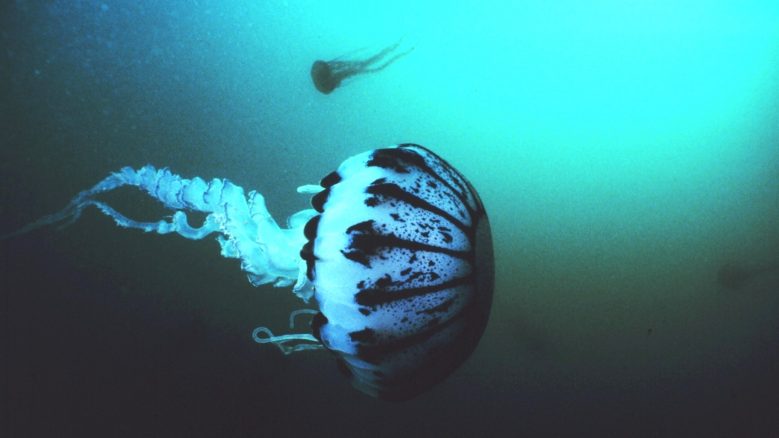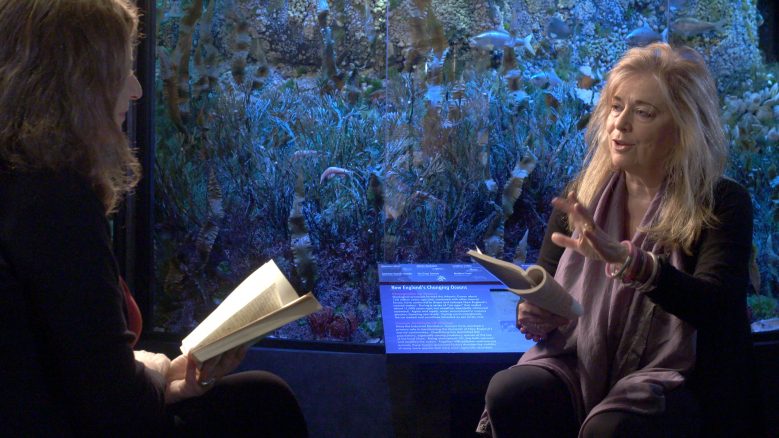In this environmental science episode, Vice President Al Gore, poet Jorie Graham, and scientists from Conservation International dive into Moore’s portrayal of the always-changing ocean, and its future in a warming world.
Interested in learning more? Poetry in America offers a wide range of courses, all dedicated to bringing poetry into classrooms and living rooms around the world.
by Marianne Moore
wade
through black jade.
Of the crow-blue mussel-shells, one keeps
adjusting the ash-heaps;
opening and shutting itself like
an
injured fan.
The barnacles which encrust the side
of the wave, cannot hide
there for the submerged shafts of the
sun,
split like spun
glass, move themselves with spotlight swiftness
into the crevices—
in and out, illuminating
the
turquoise sea
of bodies. The water drives a wedge
of iron through the iron edge
of the cliff; whereupon the stars,
pink
rice-grains, ink-
bespattered jelly-fish, crabs like green
lilies, and submarine
toadstools, slide each on the other.
All
external
marks of abuse are present on this
defiant edifice—
all the physical features of
ac-
cident—lack
of cornice, dynamite grooves, burns, and
hatchet strokes, these things stand
out on it; the chasm side is
dead.
Repeated
evidence has proved that it can live
on what can not revive
its youth. The sea grows old in it.
wade
through black jade.
Of the crow-blue mussel-shells, one keeps
adjusting the ash-heaps;
opening and shutting itself like
an
injured fan.
The barnacles which encrust the side
of the wave, cannot hide
there for the submerged shafts of the
sun,
split like spun
glass, move themselves with spotlight swiftness
into the crevices—
in and out, illuminating
the
turquoise sea
of bodies. The water drives a wedge
of iron through the iron edge
of the cliff; whereupon the stars,
pink
rice-grains, ink-
bespattered jelly-fish, crabs like green
lilies, and submarine
toadstools, slide each on the other.
All
external
marks of abuse are present on this
defiant edifice—
all the physical features of
ac-
cident—lack
of cornice, dynamite grooves, burns, and
hatchet strokes, these things stand
out on it; the chasm side is
dead.
Repeated
evidence has proved that it can live
on what can not revive
its youth. The sea grows old in it.
“The Fish” by Marianne Moore (1921)

Pulitzer Prize-winning poet Marianne Moore stands near her desk in Carlisle, Pennsylvania, where she grew up. She graduated from Bryn Mawr College with a degree in biology and histology. Courtesy of the Rosenbach Museum & Library.

M. Sanjayan, CEO of Conservation International, reflects on the playfulness of the “ink- / bespattered jellyfish” in Moore’s poem: “I can't help but smile when I think about that, because it's almost like it's a child's drawing. And that's exactly what you see when you see those jellyfish in the water. It looks like a kid just started doing that with paint.” Courtesy of the U.S. National Oceanic and Atmospheric Administration

“For me, the experience of reading this poem was conditioned by the way I, and so many others, see the ocean now as being damaged very severely, unthinkably.” Al Gore brings Marianne Moore’s poem “The Fish” into dialogue with the climate crisis and the destructive effects of changing global temperatures—one example among many—on our oceans.

“I think it's important to remember that this poem is in a book called OBSERVATIONS, and the idea of observing is a very different idea than looking, or thinking.” Contemporary poet and Pulitzer Prize-winner Jorie Graham considers the effect that Marianne Moore’s poem “The Fish” has on its reader: “She's trying to get you to both observe, but also to undergo the practice of observing so that you can be transformed.”